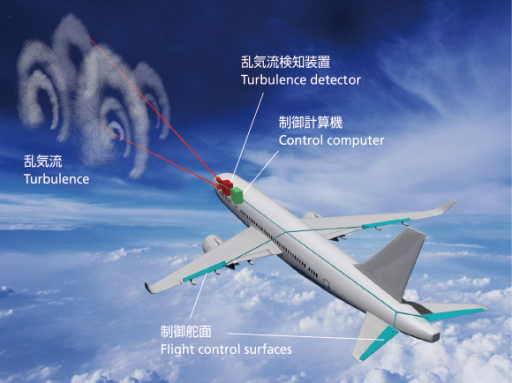Research & Development
JAXA promotes three research and development programs and a fundamental research program that underpins them.
Gust alleviation technology
Turbulences are one of the major cause of aircraft accidents. To enhance the operational safety of aircraft, JAXA has been developing various measures against turbulences, including the onboard Doppler LIDAR (Light Detection And Ranging) system that can detect clear-air turbulence in flight.
Our ongoing challenge is to develop and demonstrate the gust alleviation technology named “System for Turbulence Alleviation By Lidar Employed controller (STABLE)”. Our idea is to automatically manipulate flight control surfaces (movable wing parts that control airplane attitude) by preview control when the aircraft autopilot system receives input on air-flow vector data estimated from the turbulence detection system established in the SafeAvio project.
Background
Turbulence detection, advice, and avoidance are the key to prevent turbulence-induced aircraft accidents. Between FY2014 and FY2017, JAXA conducted the “R&D of On-board Safety Avionics Technology to Prevent Turbulence-induced Aircraft Accidents (SafeAvio)” project (FY2014 -FY2017), to develop and demonstrate the LIDAR-based onboard “turbulence-induced aircraft accident prevention system,” consisting of turbulence detection function and advisory function. The developed system was successfully demonstrated in a series of flight tests using a small jet aircraft in 2017 as part of the project, as well as in the Boeing’s ecoDemonstrator program in 2018. While the SafeAvio project addressed a system to detect clear-air turbulence ahead of the aircraft and to send a warning to the pilot, the STABLE focuses on suppressing sudden aircraft motion caused by turbulence.

An overview of JAXA's gust alleviation technology
Goals and objectives
In order to reduce turbulence-induced aircraft accidents, JAXA develops and demonstrates gust alleviation technology named “System for Turbulence Alleviation By Lidar Employed controller (STABLE)”. The STABLE is designed to alleviate vertical load caused by gust wind with preview control using data from the onboard Doppler LIDAR system, which was developed by JAXA as part of the SafeAvio project and can detect clear-air turbulence.
We plan to conduct the following R&D activities.
- Making the diameter of a two-axis LIDAR system smaller
- Developing gust alleviation control law for research aircraft and applying the developed algorithm to control computer
- Developing evaluation tool and conducting analysis
- Validating the gust alleviation control law by flight tests.
Technical committee on turbulence at WEATHER-Eye Consortium
To facilitate discussions on measures against turbulence with wider stakeholders, JAXA participate s in the technical working group on turbulence in the WEATHER-Eye Consortium, sharing the updates on the progress of the research.
Dynamic wind tunnel test
Dynamic wind tunnel test of gust alleviation control[24 seconds]
(Video from the 4th WEATHER-Eye Open Forum 2019)
Outline of the wind tunnel test
- To evaluate the effectiveness of the preview control algorithm for gust alleviation, the wind tunnel tests were conducted with following conditions and settings.
Wind tunnel test facility
- JAXA 2m × 2m low-speed Wind tunnels
- The wind speed was set to 25m/s (simulating low-seed flight of 101.4 m/s, M=0.3, 2000FT)
A gust wind generator
- The 1-cosine shape gust was generated in the test section, simulating a single discrete gust, by the gust wind generator located in front of the test section.
A half-span rigid aircraft model
- Targeting to regional jet, 48 percent scale model of the NASA Common Research Model (CRM) was used in order to make half-span size 1m, which is half of the test section’s width.
A model support system
- The aircraft model was allowed to make pitch and heave motion(up and down motion) by the support system (major analyses were conducted by fixing heave)
- A five-component balance was mounted in the model support to measure forces and moments.
A Digital Controller Unit(DCU)
- DCU regulated the control surfaces (elevator and aileron)
- Since the LIDAR system cannot be used in the wind tunnel system, the LIDAR information was emulated using the predetermined timeseries of the gust wind generator and used for the preview control law.
Simulation comparing the effect of turbulence inside the passenger cabin
The right side shows a cabin for which vertical heaving (vertical acceleration) is cut in half by applying gust alleviation technology, while the left side shows a cabin without any such measures.[62 seconds]
Update Dec.11 2020

